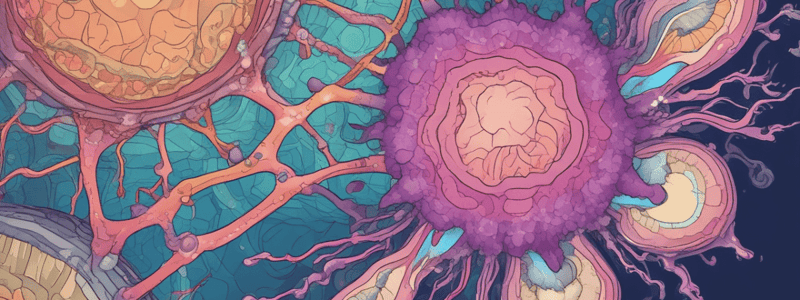Podcast
Questions and Answers
What is the primary function of secondary lymphoid organs?
What is the primary function of secondary lymphoid organs?
- To filter antigens and expose them to lymphocytes (correct)
- To store macrophages
- To produce lymphocytes
- To destroy old red cells
Which of the following is a component of the lymph node medulla?
Which of the following is a component of the lymph node medulla?
- Cords containing B cells and macrophages (correct)
- High endothelial venules
- Reticulin fibers
- Lymphoid follicles
What is the function of the germinal center in a secondary lymph node follicle?
What is the function of the germinal center in a secondary lymph node follicle?
- To contain small, dark lymphocytes
- To produce macrophages
- To contain larger lymphocytes (correct)
- To filter antigens that try to cross mucosal surfaces
Which of the following vessels carries lymph from the lymph node and returns it to the blood?
Which of the following vessels carries lymph from the lymph node and returns it to the blood?
What is the function of the spleen?
What is the function of the spleen?
What is the composition of the lymph node stroma?
What is the composition of the lymph node stroma?
Which of the following is a characteristic of primary lymphoid follicles?
Which of the following is a characteristic of primary lymphoid follicles?
Which of the following vessels penetrates the capsule of the lymph node on the convex side?
Which of the following vessels penetrates the capsule of the lymph node on the convex side?
What are the primary lymphoid organs?
What are the primary lymphoid organs?
What is the main function of the spleen in the immune system?
What is the main function of the spleen in the immune system?
What is the name given to the parenchyma of the spleen?
What is the name given to the parenchyma of the spleen?
Which of the following components is NOT found in the white pulp of the spleen?
Which of the following components is NOT found in the white pulp of the spleen?
What is the function of the splenic sinuses (sinusoids) in the red pulp?
What is the function of the splenic sinuses (sinusoids) in the red pulp?
What is the function of MALT (Mucosa-Associated Lymphoid Tissue)?
What is the function of MALT (Mucosa-Associated Lymphoid Tissue)?
Which of these is a secondary lymphoid organ?
Which of these is a secondary lymphoid organ?
What is the primary function of splenic cords?
What is the primary function of splenic cords?
Flashcards are hidden until you start studying
Study Notes
Lymphoid System Outline
- The lymphoid system consists of primary and secondary lymphoid organs
- Primary lymphoid organs: bone marrow and thymus
- Secondary lymphoid organs: lymph nodes, spleen, and mucosa-associated lymphoid tissue (MALT)
Secondary Lymphoid Organs
- Act as filters that trap antigens and expose them to lymphocytes
- Lymph nodes filter lymph, spleen filters blood, and MALT filters antigens that try to cross mucosal surfaces
Lymph Node Components
- Cortex contains lymphoid follicles composed of B cells
- Paracortex contains T cells and high endothelial venules
- Medulla composed of cords containing B cells and macrophages, and sinuses containing reticular fibers, lymph, and circulating cells and antigens
- Stroma composed of reticulin (type III collagen) fibers
Lymph Node Follicles
- Primary follicles consist of small, dark, mature lymphocytes
- Secondary follicles consist of:
- Germinal center: a lighter-staining central area containing larger lymphocytes
- Mantle zone: around germinal center; contains small, dark lymphocytes
Afferent and Efferent Lymphatic Vessels
- Afferent lymphatic vessels penetrate the capsule of the lymph node on the convex side and carry lymph with antigen and cells from sites of infection back to the lymph node
- Efferent lymphatic vessels leave through the hilum and carry lymph with lymphocytes from the lymph node and return it to the blood
Functions of the Spleen
- Filters blood (traps antigens)
- Provides a place for lymphocytes to encounter antigens and become activated
- Removes old red cells and platelets
Structure of the Spleen
- Parenchyma of spleen is called splenic pulp and consists of white pulp and red pulp
- No cortex or medulla are present
- Stroma consists of capsule, trabeculae, and reticular connective tissue
- Hilum contains nerves, arteries, and veins
White Pulp of the Spleen
- Consists of:
- Periarteriolar lymphatic sheaths (PALS): tubule-shaped collections of T cells around arterioles
- Splenic follicles (nodules): similar to secondary follicles in lymph nodes, with an additional marginal zone composed of B cells
Red Pulp of the Spleen
- Consists of:
- Splenic sinuses (sinusoids): leaky vessels lined by specialized endothelial cells and surrounded by rings of reticular fibers
- Splenic cords (cords of Billroth): contain lots of macrophages that eat old or damaged red cells
Mucosa-Associated Lymphoid Tissue (MALT)
- Unencapsulated lymphoid tissue in mucosa and submucosa of digestive, respiratory, reproductive, and urinary systems
- Catches antigens as they try to cross the mucosa and get into the body
- Found in lung and other systems
Studying That Suits You
Use AI to generate personalized quizzes and flashcards to suit your learning preferences.




